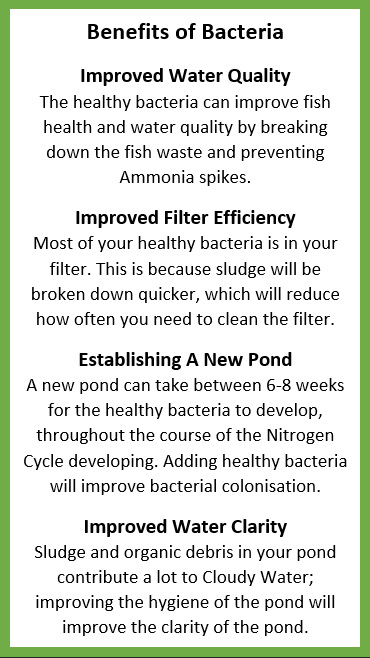Bacteria: The Importance of Healthy Bacteria

Essentially, there are two types of bacteria in your pond which develop naturally depending on the environment. Aerobic bacteria, which thrive in oxygenated ponds and are considered ‘the good bacteria’. Aerobic bacteria converts ammonia into nitrites and then into nitrates; which is part of the nitrogen cycle. There is also anaerobic bacteria, which thrives in non-oxygenated ponds and is considered ‘the bad bacteria’, which you want to try to avoid.
Beneficial bacteria will naturally develop in ponds but they can be depleted. In these cases, replenishing your bacteria is a really important step in maintaining a healthy, balanced pond. Often, the bacterial treatments provide enough bacteria to help convert the dangerous chemicals into less dangerous chemicals. This means more beneficial bacteria will result in healthier, cleaner water and a safer environment for your fish.
Various strains of algae have the same nutritional requirements as the plants in your pond; an increase in bacteria will not reduce algae in your pond. They compete for the same nutrients; a really good treatment for getting rid of algae is to increase the number of plants in your pond. We normally advise that you should cover between 40-50% of your pond with plants.
If your pond is experiencing an algae bloom, it is best to remove as much algae as possible before adding extra bacteria for your pond. Our ‘Green Water and Slimy Algae’ blog has more information on how to treat algae blooms.
Tips on Adding Bacteria
• Do not add healthy bacteria to a pond with low aeration and a build up of sludge. The bacteria will likely die off very quickly (contributing to the organic debris in the pond). Use it in an oxygenated for the maximum benefits. Our blog posts on aeration will help you keep your pond well aerated and improve the healthy bacteria in your pond naturally.
• As bacteria will not treat algae, make sure you have removed the algae before adding bacteria. Otherwise, your algae problem will get worse. Please see our Green Water blog post on how to remove algae.
• Chemicals like Chlorine will not be removed by bacteria. You may find our blog post on Chlorine helpful; an easy treatment we recommend is the PondXpert Anti-Chlorine, a treatment which quickly removes Chlorine and Chloramines from your pond.
.png)
One of our popular bacterial supplements is the PondXpert Gel Balls. These can be thrown directly into the pond or the bottom of your filter. They will release millions of healthy bacteria and enzymes, helping to treat the Ammonia and Nitrites in your pond. The treatment also has a clarifying agent, which provides a crisp finish.
Alternatively, you can purchase the Evolution Aqua Pure Pond Bombs, which are highly concentrated versions of their popular Pure Pond range.
If you are introducing a new filter to your pond, both the PondXpert Filter Start Gel and Evolution Aqua Filter Start Gel will encourage the bacteria to colonise the biomedia in your filter.
If you need any advice on bacterial development, please email us on info@pondkeeper.co.uk.